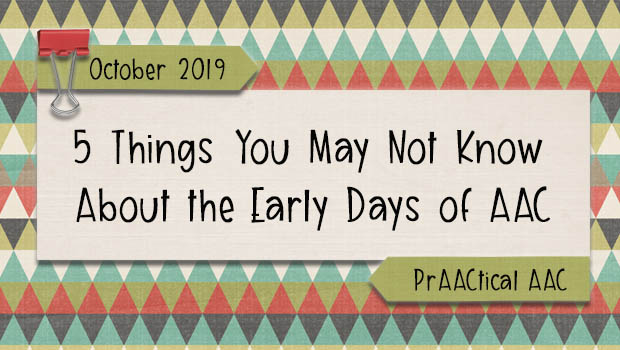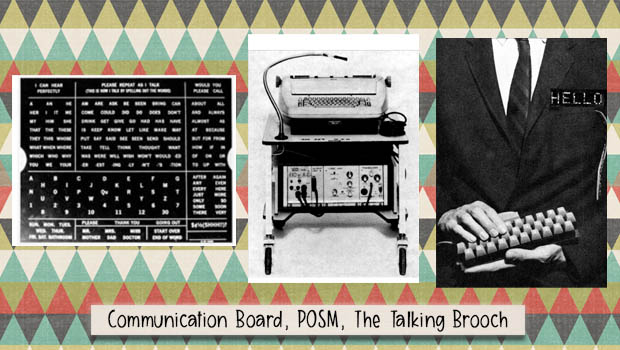5 Things You May Not Know About the Early Days of AAC

Given that October is AAC Awareness Month we thought that some of you AAC lovers would appreciate a stroll down memory lane. Here are a few things you may not know about the early days of AAC.
- The first papers that focused on AAC intervention were published in the 1950’s. In 1952, Goldstein and Cameron wrote about their use of communication boards with people with aphasia, and, a few years later, Sklar and Bennett discussed their experiences in using communication charts with this same population. Toward the end of the decade, professionals began describing their efforts in using communication boards with people with physical disabilities (e.g., Feallock,1958; Goldberg & Fenton, 1960).
- While speech-language pathologists and occupational therapists were among the first to disseminate their AAC work, professionals from many backgrounds contributed to its growth. In the early days, some of the strongest contributors to the field of AAC were rehabilitation engineers.
- The earliest known AAC implementation project was in 1964. While it did not show up in our scholarly journals, Bev Vicker wrote a comprehensive report about that Iowa-based project that was published in the early 1970’s.
- One of the first wearable AAC devices came out in the early 1970’s. The Talking Brooch (Newell, 1973) was an alphabetic display that was attached to one’s clothing. When users typed on a portable keyboard their message was displayed on The Talking Brooch.
- Alternative access was available as early as 1963, with the Patient Operated Selector Mechanism (POSM or POSSUM, Maling & Clarkson, 1963) which allowed users to control a typewriter with a sip and puff switch. The Patient Initiated Lightspot Operated Typewriter (PILOT) used light pointers to activate photoelectric cells for access. There were more options available for switch scanning in the 1970’s, and the early 1980’s brought control by eye movement (Eye Typer by Sentient Systems, which later became Dynavox). These and other AT devices were detailed in the book Aids for the Severely Handicapped (Copeland, 1974).
You can read more about the early days of AAC and see images of some of the early devices in Gregg Vanderheiden’s article, A Journey Through Early Augmentative Communication and Computer Access.
For more on the history of assistive technology, check out this past post.

::::::::::::::::::::::::::::::::::::::::::::::::::::::::::::::::::::::::::::::::::::::::::::::::;:::::::::::::::::::::::::::::::::::
References
- Copeland, K. (Ed.). (1974). Aids for the severely handicapped. New York: Grune & Stratton.
- Feallock, B. (1958). Communication for the non-vocal individual. American Journal of Occupational Therapy, 12, 60–63.
- Friedman, M.B., Kiliany, G., & Dzmura, M. (1985) An Eye Gaze Controlled Keyboard. Proceedings of the 2nd International Conference on Rehabilitation Engineering, 446–447.
- Goldberg, H. R., & Fenton, J. (1960). Aphonic communication for those with cerebral palsy: Guide for the development and use of a communication board. New York: United Cerebral Palsy of New York State.
- Goldstein, H., & Cameron, H. (1952). New method of communication for the aphasic patient. Arizona Medicine, 8, 17–21.
- Maling, R. G., & Clarkson, D. C. (1963). Electronic controls for the tetraplegic (POSSUM). Paraplegia, 1, 162–174.
- Sklar, M., & Bennett, D. (1956). Initial communication chart for aphasics. Journal of the Association of Physical and Mental Rehabilitation,
- Vicker, B. (Ed.). (1974). Nonoral Communication System Project 1964-1973. Iowa City, IA: Campus Stores.
Filed under: Featured Posts, PrAACtical Thinking
Tagged With: AAC history
This post was written by Carole Zangari

2 Comments
Surely Wordsworth summed the early days of aac up when he wrote
“Bliss it was in that dawn to be alive
But to be young was very heaven.”
Following on from that – obviously consumer technology has had a major effect on development of AAC but not necessarily in the way one might expect:
The two technologies that most changed the face of AAC in last 40 years are the home color printer and the laminator. Both in the mid-nineties. Each increasing the uses in AAC of the other. In the space of just two or three years they changed the way AAC was taught, and much tablet technology today is simply trying to emulate those materials.
Maybe also a special mention to flurescent text-highlighters which came in at the start of the 80s in time to change the way grammar is taught.